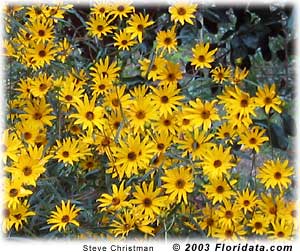
by Sheila Dunning | Oct 2, 2018
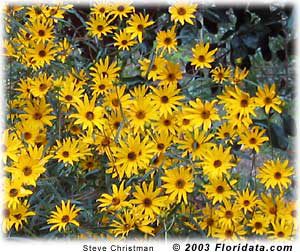 Each fall, nature puts on a brilliant show of color throughout the United States. As the temperatures drop, autumn encourages the “leaf peepers” to hit the road in search of the red-, yellow- and orange-colored leaves of the northern deciduous trees. In Northwest Florida the color of autumn isn’t just from trees. The reds, purples, yellow and white blooms and berries that appear on
Each fall, nature puts on a brilliant show of color throughout the United States. As the temperatures drop, autumn encourages the “leaf peepers” to hit the road in search of the red-, yellow- and orange-colored leaves of the northern deciduous trees. In Northwest Florida the color of autumn isn’t just from trees. The reds, purples, yellow and white blooms and berries that appear on
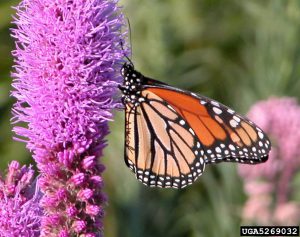
Monarch butterfly on dense blazing star (Liatris spicata var. spicata).
Beverly Turner, Jackson Minnesota, Bugwood.org
many native plants add spectacular color to the landscape. American Beautyberry, Callicarpa americana, is loaded with royal-colored fruit that will persist all winter long. Whispy pinkish-cream colored seedheads look like mist atop Purple Lovegrass, Eragrostis spectabilis and Muhlygrass, Muhlenbergia capillaris. The Monarchs and other butterfly species flock to the creamy white “fluff” that covers Saltbrush, Baccharis halimifolia. But, yellow is by far the dominant fall flower color. With all the Goldenrod, Solidago spp., Narrowleaf Sunflower, Helianthus angustifolius and Tickseed, Coreopsis spp., the roadsides are golden. When driving the roads it’s nearly impossible to not see the bright yellows in the ditches and along the wood’s edge. Golden Asters (Chrysopsis spp.), Tickseeds (Coreopsis spp.), Silkgrasses (Pityopsis spp.), Sunflowers (Helianthus spp.) and Goldenrods (Solidago spp.) are displaying their petals of gold at every turn. These wildflowers are all members of the Aster family, one of the largest plant families in the world. For most, envisioning an Aster means a flower that looks like a daisy. While many are daisy-like in structure, others lack the petals and appear more like cascading sprays. So if you are one of the many “hitting the road in search of fall color”, head to open areas. For wildflowers, that means rural locations with limited homes and businesses. Forested areas and non-grazed pastures typically have showy displays, especially when a spring burn was performed earlier in the year. Peeking out from the woods edge are the small red trumpet-shaped blooms of Red Basil, Calamintha coccinea and tall purple spikes of Gayfeather, Liatris spp.
Visit the Florida Wildflower Foundation website, www.flawildflowers.org/bloom.php, to see both what’s in bloom and the locations of the state’s prime viewing areas. These are all native wildflowers that can be obtained through seed companies. Many are also available as potted plants at the local nurseries. Read the name carefully though. There are cultivated varieties that may appear or perform differently than those that naturally occur in Northwest Florida. For more information on Common Native Wildflowers of North Florida go to http://edis.ifas.ufl.edu/ep061
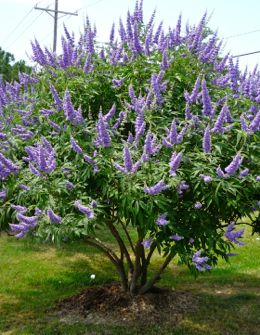
by Sheila Dunning | Aug 29, 2018
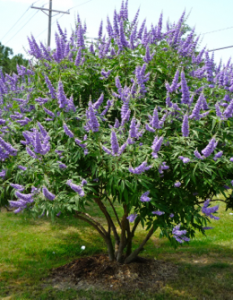 Chaste tree. The showy chaste tree makes an attractive specimen as the centerpiece of your landscape bed or in a large container on the deck. Easy-to-grow, drought resistant, and attractive to butterflies and bees, Vitex agnus-castus is a multi-stemmed small tree with fragrant, upwardly pointing lavender blooms and gray-green foliage. The chaste tree’s palmately divided leaves resemble those of the marijuana (Cannabis sativa) plant; its flowers can be mistaken for butterfly bush (Buddleia sp.); and the dry, darkened drupes can be used for seasoning, similar to black pepper, making it a conversation piece for those unfamiliar with the tree.
Chaste tree. The showy chaste tree makes an attractive specimen as the centerpiece of your landscape bed or in a large container on the deck. Easy-to-grow, drought resistant, and attractive to butterflies and bees, Vitex agnus-castus is a multi-stemmed small tree with fragrant, upwardly pointing lavender blooms and gray-green foliage. The chaste tree’s palmately divided leaves resemble those of the marijuana (Cannabis sativa) plant; its flowers can be mistaken for butterfly bush (Buddleia sp.); and the dry, darkened drupes can be used for seasoning, similar to black pepper, making it a conversation piece for those unfamiliar with the tree.
Vitex , with its sage-scented leaves that were once believed to have a sedative effect, has the common name “Chastetree” since Athenian women used the leaves in their beds to keep themselves chaste during the feasts of Ceres, a Roman festival held on April 12. In modern times, the tree is more often planted where beekeepers visit in order to promote excellent honey production or simply included in the landscape for the enjoyment of its showy, summer display of violet panicles.
Chaste tree is native to woodlands and dry areas of southern Europe and western Asia. It will thrive in almost any soil that has good drainage, prefers full sun or light shade, and can even tolerate moderate salt air. Vitex is a sprawling plant that grows 10-20 feet high and wide, that looks best unpruned. If pruning is desired to control the size, it should be done in the winter, since it is a deciduous tree and the blooms form on new wood. The chaste tree can take care of itself, but can be pushed to faster growth with light applications of fertilizer in spring and early summer and by mulching around the plant. There are no pests of major concern associated with this species, but, root rot can cause decline in soils that are kept too moist.

by Sheila Dunning | Aug 2, 2018
Although it has been very hot this summer throughout the Florida Panhandle, many areas have been blessed with afternoon showers several day in a row. Historically, this has been the typical Northwest Florida weather pattern known as the ‘Dog Days’. 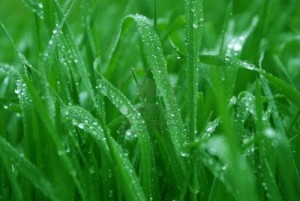
Yet, many landscape sprinkler systems were still running. One has to ask, “Where are all the rain shut-off devices?”. Florida is one of just a few states with a rain sensor statute. Since May 1991, new installations of irrigation systems have been required to include a rain shut-off device. However, no wording was included to cover installation or maintenance. The 2010 statute change now states the following: “Any person who operates an automatic landscape system shall properly install, maintain and operate technology that inhibits or interrupts operation of the system during periods of sufficient moisture.” (Florida Statute 373.62).
Thus, ALL automatic landscape irrigation systems require rain sensors, or other shut-off devices such as soil moisture sensor irrigation controllers. No “grandfather clause” was included for existing systems. Regardless of when it was installed, every sprinkler system must have an operational rain shut-off device. Irrigation contractors can be fined for working on a system without checking out and/or connecting a device.
Moisture sensing technology conserves water, saves money, reduces wear on irrigation system components, reduces disease and helps protect water resources from runoff. Previous research has shown that homeowners using in-ground, automatic irrigation systems, typically in Florida, apply 47% more water for landscape irrigation than homeowners without automatic irrigation systems. This over-irrigation is largely due to a “set it and forget it” mentality despite seasonal fluctuations in plant water needs. If the water costs and the amount of water applied per watering cycle are known, it is easy to calculate how much money is being saved each time the sensor interrupts the program. For example, if a system irrigates ½ acre of turf and is set to deliver ½ inch of water to each zone, approximately 13,576 gallons of water will be used during each watering event. If the cost of the water is $2.00 per thousand gallons, every time the sprinkler system comes on the water bill will be $27.15. A significant amount of money and water can be saved by maintaining a rain shut-off device.
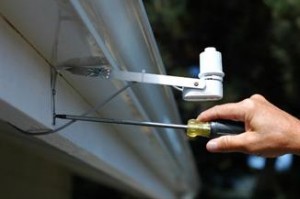 Irrigation is common in Florida landscapes because of sporadic rainfall and the low water holding capacity of sandy soils. Water conservation is a growing issue due to increased demands from a growing population. The least expensive and most common rain sensor device is the expansion disk rain shut-off. Expanding cork disks trigger a pressure switch. The expansion space can be easily adjusted by rotation of the disk cover to a predetermined amount of rain required to trigger the switch. The amount of rain that will interrupt the irrigation system is marked on the adjustment cap. A rain sensor must be mounted where it will be exposed to unobstructed rainfall, typically installed near the roofline on the side of a building.
Irrigation is common in Florida landscapes because of sporadic rainfall and the low water holding capacity of sandy soils. Water conservation is a growing issue due to increased demands from a growing population. The least expensive and most common rain sensor device is the expansion disk rain shut-off. Expanding cork disks trigger a pressure switch. The expansion space can be easily adjusted by rotation of the disk cover to a predetermined amount of rain required to trigger the switch. The amount of rain that will interrupt the irrigation system is marked on the adjustment cap. A rain sensor must be mounted where it will be exposed to unobstructed rainfall, typically installed near the roofline on the side of a building.
Irrigation control technology that improves water application efficiency is now available. Soil moisture sensors (SMS) can reduce the number of unnecessary irrigation events. Most soil moisture sensors are designed to estimate soil volumetric water content based on the soil’s ability to transmit electricity, which increases as the water content of the soil increases. Bypass type soil moisture irrigation controllers use water content information from the sensor to either allow or bypass scheduled irrigation cycles on the irrigation timer. Another type of control technique with SMS devices is “on-demand” where the controller initiates irrigation at a low threshold and terminates irrigation at a high threshold. A single sensor can be used to control the irrigation for many zones or multiple sensors can be used to irrigate individual zones. In the case of one sensor for several zones, the zone that is normally the driest, or most in need of irrigation, is selected for placement of the sensor in order to ensure adequate irrigation in all zones. Sensors should be buried in the root zone of the plants to be irrigated. For turfgrass, the sensor should typically be buried at about three inches deep. The placement of SMS should be at least 5 feet from hard surfaces and sprinkler heads. The sensor needs to be calibrated and/or the soil water content threshold needs to be selected.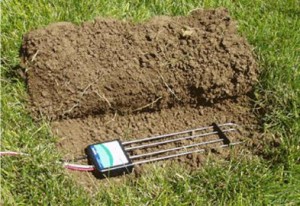
The amount of water that can be saved using rain shut-off devices is substantial since water use increases substantially during summer months. Remember that every drop that hits the ground will be picking up pollutants as it flows to our groundwater. Nonpoint source pollution is the leading cause of water quality problems. These pollutants have harmful effects on drinking water supplies, recreation, fisheries and wildlife. By only irrigating when the soil needs it, you are also preventing contamination of drinking water.
This article is being reissued as part of our ‘Best Of” series, from August 2013 .
by Sheila Dunning | Jun 28, 2018
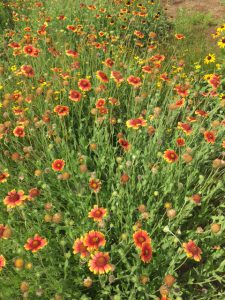 National Pollinator Week is only recognized in June, but efforts to encourage pollinators shouldn’t end then.
National Pollinator Week is only recognized in June, but efforts to encourage pollinators shouldn’t end then.
Pollination occurs when pollen grains are moved between two flowers of the same species, or within a single flower, by wind or animals that are pollinators. Successful pollination, which may require visits by multiple pollinators to a single flower, results in healthy fruit and fertile seeds, allowing plants to reproduce. Without pollinators, we simply wouldn’t have many crops!
Worldwide, approximately 1,000 plants grown for food, beverages, fibers, spices, and medicines need to be pollinated by animals in order to produce the goods on which we depend. Foods and beverages produced with the help of pollinators include blueberries, chocolate, coffee, melons, peaches, pumpkins, vanilla, and almonds.
About 75% of all flowering plants rely on animal pollinators and over 200,000 species of animals act as pollinators. Of those, about 1,000 are hummingbirds, bats, and small mammals. The rest are insects such as beetles, bees, ants, wasps, butterflies, and moths. Western honey bees are the most common.
Most species of bees don’t sting. Although all female bees are physically capable of stinging, most bee species native to the U.S. are “solitary bees,” that is, not living in colonies and don’t sting unless they are physically threatened or injured. Only honey bees are defensive and may chase someone who disturbs their hive.
It is wise, though, to avoid disturbing any bee or insect nest.
What everyone can do for pollinators:
Watch for pollinators. Get connected with nature. Take a walk, experience the landscape and look for pollinators which are most active midday in sunny, planted areas.
Reduce your impact. Reduce or eliminate your pesticide use, increase green spaces, and minimize impervious surfaces.
Plant for pollinators. Create pollinator-friendly habitat with native flowering plants that supply pollinators with nectar, pollen, and homes. For a list of plant choices go to: http://gardeningsolutions.ifas.ufl.edu/design/gardening-with-wildlife/bee-plants.html
What you can do to create a pollinator-friendly habitat:
Design your garden so that there is a continuous succession of plants flowering from spring through fall. Check for the species or cultivars best suited to your area.
Plant native to your region using plants that provide nectar for adults plus food for insect larvae, such as milkweed for monarchs. If you do use non-native plants, choose ones that don’t spread easily, since these could become invasive.
Select old-fashioned varieties of flowers whenever possible because breeding has caused some modern blooms to lose their fragrance and/or the nectar/pollen needed to attract and feed pollinators.
Install ‘houses’ for bats and native bees. For examples go to: http://edis.ifas.ufl.edu/uw290 or http://gardeningsolutions.ifas.ufl.edu/design/gardening-with-wildlife/pollinator-hotels.html
Avoid pesticides, even so-called “natural” ones such as Bacillus thuringiensis (Bt). If you must use them, use the most selective and least toxic ones and apply them at night when most pollinators aren’t active.
Supply water for all wildlife. A dripping faucet or a suspended container with a pinhole in the bottom is sufficient for some insects. Other wildlife need a small dish of water.
Provide water for butterflies without letting it become a mosquito breeding area. Refill containers daily or bury a shallow plant saucer to its rim in a sunny area, fill it with coarse pine bark, sand or stones and fill to overflowing with water.
Fun facts:
A tiny fly (a “midge”) no bigger than a pinhead is responsible for the world’s supply of chocolate
One out of every three mouthfuls of food we eat is delivered to us by pollinators.

by Sheila Dunning | Apr 23, 2018
With cool, foggy mornings you may have noticed the large number of spider webs hanging on low vegetation. Some of them have unusual shapes. One of the most notable is the bowl and doily spider. This spider (Frontinella pyramitela) is a species of sheet web weavers found throughout the United States, including Northwest Florida.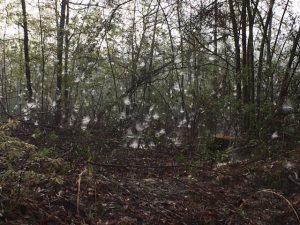
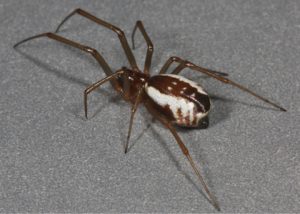 It is a small spider, about 3-4 mm (0.16 in) long, boldly marked with black and white stripes on the abdomen, a brown cephalothorax, and brownish legs. They weave a fairly complex shaped webs only a few inches across, usually well off the ground and stretched between twigs or other objects. Webs consist of an inverted dome-shaped web, or “bowl”, suspended above a horizontal sheet web, or “doily”, hence its common name. The webs are approximately circular when viewed from above, where there is a tangled scaffold “knock down” threads of silk invisible to flying insects. The webs are commonly seen in weedy fields and in shrubs.
It is a small spider, about 3-4 mm (0.16 in) long, boldly marked with black and white stripes on the abdomen, a brown cephalothorax, and brownish legs. They weave a fairly complex shaped webs only a few inches across, usually well off the ground and stretched between twigs or other objects. Webs consist of an inverted dome-shaped web, or “bowl”, suspended above a horizontal sheet web, or “doily”, hence its common name. The webs are approximately circular when viewed from above, where there is a tangled scaffold “knock down” threads of silk invisible to flying insects. The webs are commonly seen in weedy fields and in shrubs.
Small flies, gnats and other small insects crash into the strands of barrier silk and fall down into the non-sticky webbing. The spider hangs from the underside of the “bowl”, and bites through the web, pulling the prey through in order to consume them while resting comfortably on the “doily”. Bowl and doily spiders serve a very important ecological role by controlling human-biting and plant damaging insects.
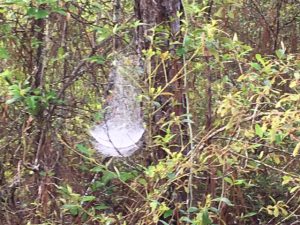 Among web-building spiders, bowl and doily spiders (Frontinella pyramitela) are unusual because both males and females often cohabitate. The males rarely build webs, however, and so depend upon females ‘ snares for food. These cohabiting males capture about 32% of the prey that hit the web despite the female’s efforts to capture the same prey.
Among web-building spiders, bowl and doily spiders (Frontinella pyramitela) are unusual because both males and females often cohabitate. The males rarely build webs, however, and so depend upon females ‘ snares for food. These cohabiting males capture about 32% of the prey that hit the web despite the female’s efforts to capture the same prey.
Mating in this species occurs on the underside of the bowl of the female’s web and is preceded by a complex vibration- and chemical-mediated courtship during the late summer. Eggs are laid in silken sacs in the web or hiding in leaf litter on the ground. Both eggs and adults have been known to overwinter. Like all spiders, bowl and doily spiders develop through simple metamorphosis: spiderlings look like tiny adult spiders (but with lighter coloration), and shed their outer skin in order to grow. Most sheet web weavers live only one year.

 Each fall, nature puts on a brilliant show of color throughout the United States. As the temperatures drop, autumn encourages the “leaf peepers” to hit the road in search of the red-, yellow- and orange-colored leaves of the northern deciduous trees. In Northwest Florida the color of autumn isn’t just from trees. The reds, purples, yellow and white blooms and berries that appear on
Each fall, nature puts on a brilliant show of color throughout the United States. As the temperatures drop, autumn encourages the “leaf peepers” to hit the road in search of the red-, yellow- and orange-colored leaves of the northern deciduous trees. In Northwest Florida the color of autumn isn’t just from trees. The reds, purples, yellow and white blooms and berries that appear on












